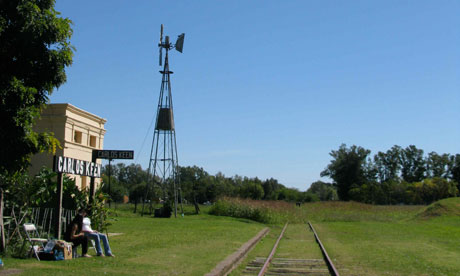
At first glance, Carlos Keen looks like any other forgotten railway town in the Argentinian pampas. The old brick station stands in its centre, a stoic reminder of the past; long grass and dandelions have long crept over the railway tracks; the sound of crickets has replaced the train whistles. In an overgrown field a tethered horse turns his head to look at two local boys kicking a football.
Look a little closer, however, and you'll see that this tiny, dirt-track village is not as deserted as it first seems. Carlos Keen (population 500) has reinvented itself as a weekend retreat for food lovers. Restaurants have been popping up in all corners, drawing in daytrippers from Buenos Aires (two hours' drive to the east) and the nearby tourist town of Luján. The speciality? Good, old-fashioned country cooking.
Carlos Keen – like many similar turn-of-the-20th-century railway towns – has the hallmarks of a place that was supposed to grow with increasing trade: the big church, the station house, the huge central square. Argentina once had one of the largest rail networks in the world, but it was badly hit by an unsuccessful plan to nationalise it in 1940 and a disastrous attempt to re-privatise it in 1993. Hundreds of stations closed and many of the small towns that relied on them were threatened with extinction. Now Carlos Keen is among those trying to reverse its fortunes.
The town's transformation started with the opening of the family-run Angelus (angelusrestaurant.com.ar) 12 years ago. Today its gleaming wine glasses and starched tablecloths wouldn't look out of place in Buenos Aires' upmarket Palermo district, but the bare-brick walls and antiques give it the feel of a country dining room.
"Our intention is to make food in the style that I was taught at home," says owner and lifelong resident Marina Semino. The food here is 100% Argentinian in style, with a set menu costing 80 pesos (£13).
On a sunny spring day, we take a table in the garden. Almost everyone has come with a group – as a family or with friends. We start off with a picada, a wooden board loaded with simple finger food, such as cheese, ham and olives. It makes the perfect accompaniment to a large glass of dark Malbec. Then come the empanadas. This is only the starter, but we're already feeling quite full and, as the Argentinians put it so delightfully, "un poco en pedo" (literally: "a little bit in farts", or slightly drunk). Fortunately, the deliberately leisurely service between courses allows us time to recover, with a stroll around the grounds. A platter piled high with the country's famously succulent meat arrives sizzling on a hot plate, as if creating its own fanfare. The waitress assures us there is plenty more where this came from, and it becomes clear that leaving this town hungry is not an option.
The Argentinian campo (countryside) may not be ideal territory for vegetarians, but most places also do a good range of homemade pasta. A special mention is deserved for La Casona de Carlos Keen, run by Quintana and Mitre, who make delicious ravioli with pumpkin, honey and cracked black pepper. La Casona is a little cheaper than Angelus, and slightly more rustic.
Carlos Keen now has around a dozen restaurants, most lining the dusty street that borders its central playing field. Menus are pretty much the same in all of them, so your best bet is to take a stroll around and see what takes your fancy. Set slightly back from the main square and worth a few minutes' extra walk is Los Girasoles (caminoabierto.org.ar). Run by Susana Esmoris and her husband Hugo Centineo, this organic farm-cum-restaurant-cum-guesthouse is also a refuge for local boys from troubled homes.
Among the vegetable plots and animal pens, Susie teaches the boys about cooking, farming, recycling and alternative energy via their solar and clay ovens. "We have 25 young boys here, all working as a team. It's marvellous," she enthuses. With their help, she serves dishes such as rabbit in garlic and white wine sauce, followed by crêpes with lashings of homemade dulce de leche (milk caramel).
Carlos Keen isn't the only old Argentinian railway town to have reinvented itself in recent times. Just over 25km further east lies Tomás Jofré, the self-appointed "little town advocating gastronomy". Here Cua Cua (cuacua.com.ar) is a good spot for a parrillada (a belt-unbuckling mixed grill) and if you overindulge, there are simple rooms for overnight stays.
Weekend trade has also been reaching sleepy Uribelarrea (uribelarrea.com), 80km south-west of Buenos Aires. El Palenque, its classic pulpería (grocery store/bar) on Plaza Centenario, dates from the late 1800s, while more recently its timewarp streets have been used as backdrops for the film Evita and for Francis Ford Coppola's recent drama Teatro.
The common thread of these old railway towns is that meals are designed to be eaten at a pace so leisurely that lunch is a day-long affair. There's no such thing as fast food in these parts. "We never hurry here," says Susana of her life in the pampas. "Every meal has an intention. When people eat it, they notice."
That must be why the daytrippers keep coming back.
• All these towns are easily accessible from the capital. Some restaurants are open only at weekends and public holidays, and most won't take credit cards. To get to Carlos Keen from Buenos Aires, catch the number 57 bus from Plaza Italia or Plaza Miserere to Luján (1½ to 2 hours), then take a bus or taxi to the village (10-15 minutes). To get to Tomás Jofré catch the same bus line to Mercedes and take a taxi. Uribelarrea is a 1½-hour bus trip from Buenos Aires with lobosbus.com.ar

